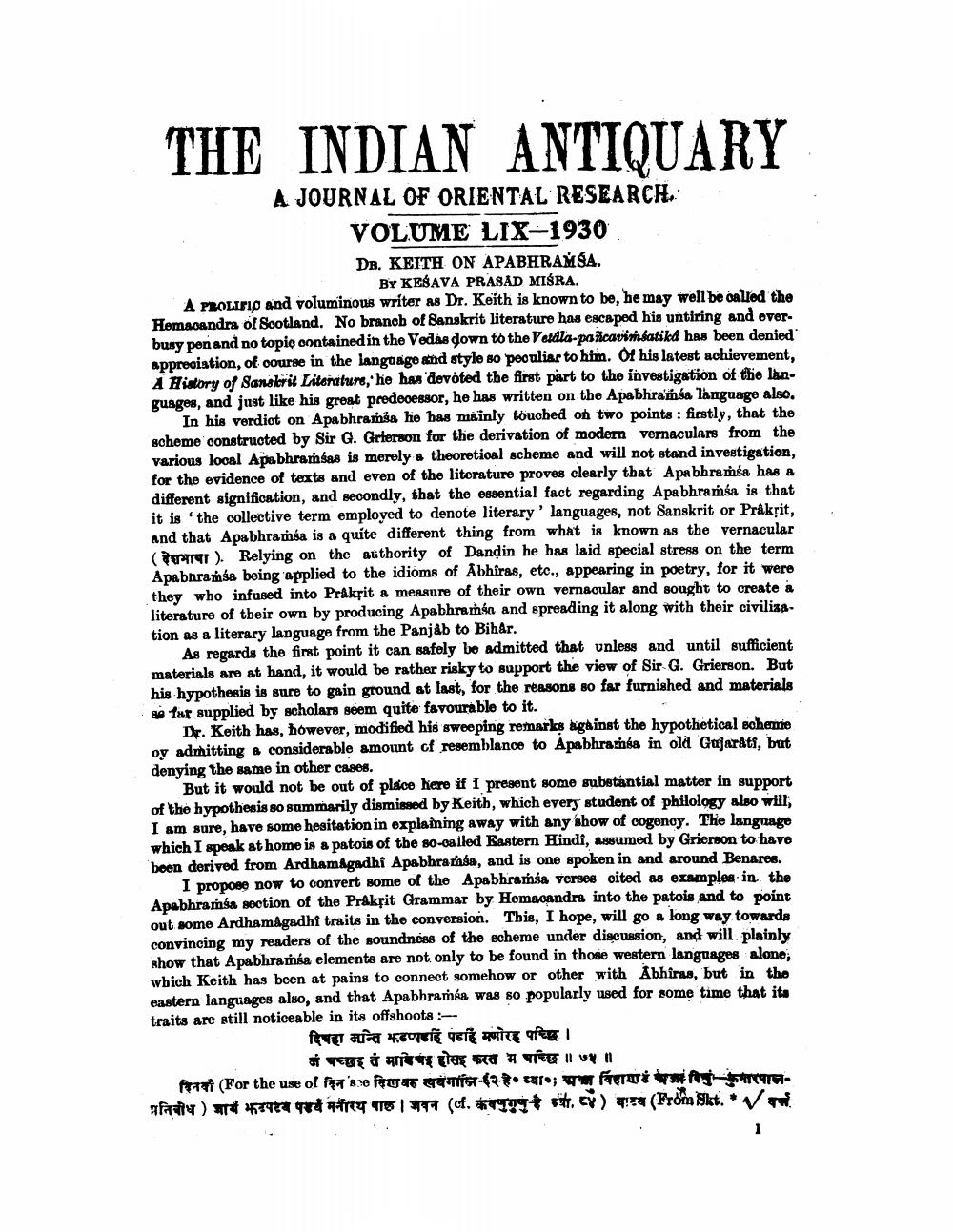Book Title: Indian Antiquary Vol 59 Author(s): Richard Carnac Temple, Charles E A W Oldham, S Krishnaswami Aiyangar, Devadatta Ramkrishna Bhandarka Publisher: Swati Publications View full book textPage 7
________________ THE INDIAN ANTIQUARY A JOURNAL OF ORIENTAL RESEARCH. VOLUME LIX-1930 DR. KEITH ON APABHRASA. BY KEŠAVA PRASAD MIŚRA. A PROLIFID and voluminous writer as Dr. Keith is known to be, he may well be called the Hemacandra of Sootland. No branch of Sanskrit literature has escaped his untiring and overbusy pen and no topic contained in the Vedas down to the Vetala-poncavimfatika has been denied appreciation, of course in the language and style so peouliar to him. Of his latest achievement, History of Sanskrit Literature, he has devoted the first part to the investigation of the languages, and just like his great predecessor, he has written on the Apabhraísa language also In his verdiot on Apabhramsa he has mainly touched on two points: firstly, that the scheme constructed by Sir G. Grierson for the derivation of modern vernaculars from the various looal Apabhrarbas is merely a theoretioal scheme and will not stand investigation, for the evidence of texts and even of the literature proves clearly that Apabhramśa has a different signification, and secondly, that the essential fact regarding Apabhramsa is that it is the collective term employed to denote literary languages, not Sanskrit or Prakrit, and that Apa bhramsa is a quite different thing from what is known as the vernacular ( TCT). Relying on the authority of Dandin he has laid special stress on the term Apabhramśa being applied to the idioms of Abhiras, etc., appearing in poetry, for it were they who infused into Pråkpit a measure of their own vernacular and sought to create & literature of their own by producing Apabhramsa and spreading it along with their civilization as a literary language from the Panjab to Bihar. As regards the first point it can safely be admitted that unless and until sufficient materials are at hand, it would be rather risky to support the view of Sir G. Grierson. But his hypothesis is sure to gain ground at last, for the reasons so far furnished and materials se tar supplied by scholars seem quite favourable to it. Dr. Keith has, however, modified his sweeping remarks against the hypothetical scheme py adrhitting a considerable amount of resemblance to Apabhrathia in old Gujarats, but denying the same in other cases. But it would not be out of place here if I present some substantial matter in support of the hypothesis so summarily dismissed by Keith, which every student of philology also will I am sure, have some hesitation in explaining away with any show of cogenoy. The langnage which I speak at home is a patois of the so-called Eastern Hindi, assumed by Grierson to have boon derived from Ardham&gadhf Apabhramsa, and is one spoken in and around Benares. I propoee now to convert some of the Apabhramsa verses cited as examples in the Apabhramsa section of the Pråkfit Grammar by Hemacandra into the patois and to point out some Ardhamagadhi traits in the conversion. This, I hope, will go a long way towards convincing my readers of the soundness of the scheme under discussion, and will plainly show that Apabhramsa elements are not only to be found in those western languages alone, wbich Keith has been at pains to connect somehow or other with Abhiras, but in the eastern languages also, and that Apabhramba was so popularly used for some time that ita traits are still noticeable in its offshoots दिपहा मान्त झडप्पडहिं पडहि ममोरह पच्छि। मंपच्छह तं माविषद होसइ करत म पच्छि ॥ ५ ॥ frat (For the use of fase fua *77* ; fremuri TAafrais ) ard 17984 Tot air er 779 (cf. *TIT . CY) TT (From Skt. VPage Navigation
1 ... 5 6 7 8 9 10 11 12 13 14 15 16 17 18 19 20 21 22 23 24 25 26 27 28 29 30 31 32 33 34 35 36 37 38 39 40 41 42 43 44 45 46 47 48 49 50 51 52 53 54 55 56 57 58 59 60 61 62 63 64 65 66 67 68 69 70 71 72 ... 380
